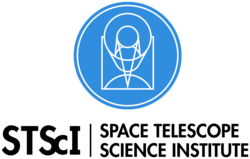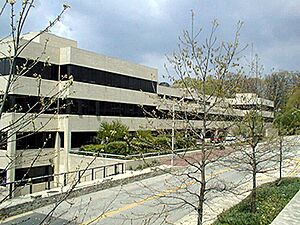Space Telescope Science Institute facts for kids
 |
|
| Established | 1981 |
|---|---|
| Location |
,
,
Maryland
,
U.S.
|
| Coordinates | 39°19′58″N 76°37′24″W / 39.33278°N 76.62333°W |
The Space Telescope Science Institute (often called STScI) is a special place that helps run some of the most famous space telescopes. It's like the mission control for science! STScI manages the science for the Hubble Space Telescope (HST) and the James Webb Space Telescope (JWST). It also handles the science for the upcoming Nancy Grace Roman Space Telescope.
STScI started in 1981. It works for NASA and is run by a group called the Association of Universities for Research in Astronomy (AURA). You can find STScI's offices in Baltimore, Maryland, on the Johns Hopkins University campus and in the Rotunda building.
Besides running Hubble and Webb, STScI also takes care of the Mikulski Archive for Space Telescopes (MAST). This is a huge library of space data! It holds information from many missions, including Hubble, Webb, Kepler, TESS, Gaia, and Pan-STARRS.
Most of STScI's money comes from NASA. They also get some funding from the European Space Agency (ESA).
The people who work at STScI are very diverse. They include scientists (like astronomers), engineers who work on spacecraft and software, data experts, and people who share space discoveries with the public. In 2021, about 850 people worked at STScI. Around 200 of them are scientists with advanced degrees.
STScI helps NASA and astronomers around the world. They make sure telescopes like Hubble and Webb collect amazing data. They also share these discoveries with everyone. This includes creating resources for museums, planetariums, and the general public.
Contents
- What Does STScI Do?
- Choosing Science Projects
- Scheduling Observations
- Running the Telescopes
- Processing Science Data
- Storing and Sharing Data
- Calibrating Instruments
- Getting Help After Observations
- Helping the Science Community
- Developing Computer Systems
- Supporting Mission Development
- Scientific Research
- Sharing Discoveries with Everyone
What Does STScI Do?
STScI does many important jobs to help us explore space. They work closely with astronomers to make sure the telescopes are used in the best way possible.
Choosing Science Projects
STScI helps decide which science projects Hubble will work on each year. It's a big process!
- Calling for Ideas: First, STScI asks scientists from all over the world to send in their ideas for what Hubble should look at. They explain what the telescope can do.
- Reviewing Proposals: A special committee of about 100 astronomers reviews all the ideas. They look at 700 to 1100 proposals each year.
- Making Selections: Only about 15-20% of the ideas are chosen. These chosen projects get time on the telescope.
- Planning the Observations: If a project is chosen, the scientists then give STScI very detailed instructions. This includes how long the telescope should look at something and where it should point. STScI even has special tools to help scientists figure out how much observing time they need.
Scheduling Observations
Once the projects are chosen, STScI creates a plan for the entire year. They figure out the best times to schedule each observation. This makes sure the telescope is used efficiently.
- Weekly Plans: Detailed schedules are made every week. For Hubble, this includes planning how data will be sent back to Earth using special satellites.
- Adjusting Plans: Sometimes, plans change. For example, if a supernova (a huge star explosion) happens, STScI can quickly adjust the schedule to observe it.
- Webb Telescope Planning: STScI is also developing similar plans for the James Webb Space Telescope. Webb is much farther from Earth than Hubble, so its operations are a bit different.
Running the Telescopes
STScI helps keep Hubble running smoothly every day.
- Daily Checks: They send commands to Hubble about four times a day. They also receive data from the telescope about ten times a day.
- Monitoring Health: Experts at STScI constantly watch over Hubble to make sure it's healthy and working correctly. This happens 24 hours a day!
- Location: These daily operations for Hubble happen at NASA's Goddard Space Flight Center in Maryland.
Processing Science Data
When data from Hubble arrives at STScI, it's not ready to be used right away.
- Converting Data: The data goes through special computer programs. These programs change the data into a standard format that scientists can use.
- Cleaning Up Data: They also fix any missing data and remove "noise" or errors from the telescope's instruments.
- Calibrating Data: This step makes sure the data is accurate. It corrects for things like how bright objects appear and where they are in the sky. STScI is also setting up similar processes for data from the Kepler and Webb telescopes.
Storing and Sharing Data
All the science data from Hubble is saved forever in an archive.
- Private Period: For the first year, only the scientists who asked for the observations can access the data.
- Public Access: After one year, anyone can access the data! This means scientists worldwide can use it for their own research.
- Automatic Updates: When someone gets data from the archive, it's automatically re-calibrated with the latest information. This ensures the data is as accurate as possible.
- Huge Archive: STScI's archive holds over 30 terabytes of data. That's a massive amount of information! Every day, new data is added, and lots of data is sent out to users.
- Easy Access: You can access this data through websites like STScI's archive website and the Hubble Legacy Archive.
Calibrating Instruments
STScI makes sure the instruments on Hubble and Webb are working perfectly.
- Yearly Plans: Each year, they create a plan to calibrate the instruments. This involves taking special measurements using sources on the telescope or by observing known stars.
- Keeping Instruments Active: Hubble has had 12 science instruments over its lifetime. Six of them are still active today. Some were even repaired in space!
- Light Detection: Hubble's instruments can see light from ultraviolet to near infrared. Webb's instruments will see light from red optical wavelengths to mid-infrared.
Here's a table of some of the instruments:
| Instrument name (and abbreviation) | What it does | Status | Telescope |
|---|---|---|---|
| High Speed Photometer (HSP) | Measures how bright things are very quickly | Decommissioned in 1993 | HST |
| Wide Field and Planetary Camera (WFPC) | Takes UV/Optical pictures | Decommissioned in 1993 | HST |
| Faint Object Spectrograph (FOS) | Breaks down UV/Optical light into colors | Decommissioned in 1997 | HST |
| Goddard High Resolution Spectrograph (GHRS) | Breaks down UV/Optical light into colors with high detail | Decommissioned in 1997 | HST |
| Faint Object Camera (FOC) | Takes UV/Optical pictures | Decommissioned in 2002 | HST |
| Wide Field and Planetary Camera 2 (WFPC2) | Takes UV/Optical pictures | Decommissioned in 2009 | HST |
| Fine Guidance Sensor (FGS) | Measures exact positions of stars | Active | HST |
| Space Telescope Imaging Spectrograph (STIS) | Takes UV/Optical pictures and breaks down light | Active (repaired) | HST |
| Near Infrared Camera and Multi-Object Spectrometer (NICMOS) | Takes Near-Infrared pictures and breaks down light | Active | HST |
| Advanced Camera for Surveys (ACS) | Takes UV/Optical pictures and breaks down light | SBC and WFC (repaired) Active; HRC Inactive | HST |
| Cosmic Origins Spectrograph (COS) | Breaks down UV light into colors | Active | HST |
| Wide Field Camera 3 (WFC3) | Takes UV/Optical/Near-Infrared pictures and breaks down light | Active | HST |
| Near Infrared Camera (NIRCam) | Takes Optical/Near-Infrared pictures | Active-Undergoing Calibration | JWST |
| Near Infrared Spectrograph (NIRSpec) | Breaks down Near-Infrared light into colors | Active-Undergoing Calibration | JWST |
| MIRI (Mid-Infrared Instrument) (MIRI) | Takes Mid-Infrared pictures and breaks down light | Active-Undergoing Calibration | JWST |
| Tunable Filter Imager (FGS-TFI) | Takes Near to Mid-Infrared pictures | Active-Undergoing Calibration | JWST |
STScI staff also studies how the instruments perform. This helps scientists understand their data better. They also monitor and adjust the telescope itself, like making sure Hubble's focus is perfect. For Webb, they use a special system to adjust its segmented mirrors.
Getting Help After Observations
STScI has a HelpDesk. Scientists can contact it with any questions. This could be about how to send in a proposal or how to understand their data.
Helping the Science Community
STScI also does big science projects for the entire astronomy community.
- Famous Projects: These include the Hubble Deep Field (HDF), the Hubble Deep Field South (HDFS), and the Ultra Deep Field (UDF). These projects take very long exposures to see extremely faint and distant galaxies.
- Sharing Data: The raw and processed data from these observations are made public almost immediately. Many astronomers use this data for their own research.
Developing Computer Systems
STScI builds and maintains the computer systems that help run Hubble's science operations.
- Constant Updates: These systems have been updated many times over Hubble's lifetime. They've been improved to be more efficient and easier to use.
- Supporting New Instruments: The systems are also changed to support new instruments added to the telescope.
- Lots of Code: STScI's software engineers manage about 7.9 million lines of computer code!
Supporting Mission Development
STScI works with NASA and other experts to plan how missions will work.
- Hubble Servicing: For Hubble, they helped decide what repairs and upgrades were needed during astronaut servicing missions.
- Webb Planning: For Webb, they helped define the science goals and the overall design of the mission. They focus on making sure the telescopes can do amazing science and operate smoothly.
Scientific Research
STScI also supports new scientists and conducts its own research.
- Hubble Fellowship Program: This program helps talented young scientists do research related to space telescopes. It now includes research for missions like the Herschel Space Observatory, Hubble, Webb, Stratospheric Observatory for Infrared Astronomy (SOFIA), and the Spitzer Space Telescope.
- Student Interns: STScI has a summer program for college students. They get to work with scientists and gain hands-on experience in astronomy.
- Staff Research: The scientists at STScI do their own research. They study everything from our Solar System and exoplanets to how stars and galaxies form.
- Workshops: STScI hosts scientific meetings and workshops each year. This helps scientists share their discoveries and learn from each other.
Sharing Discoveries with Everyone
STScI has a special team called the Office of Public Outreach (OPO). Their job is to share the amazing science and discoveries from Hubble, Webb, Roman, and astronomy in general with the public.
- News Releases: OPO creates about 40 new press releases each year about Hubble's discoveries. These include news stories, images, animations, and other information for media.
- Public Resources: They also create many astronomy-related products for everyone. This includes articles, images, videos, and interactive tools.
- Websites: Most of these resources are shared on STScI's websites, like Hubblesite, Webbtelescope, ViewSpace, and Illuminated Universe. They also use social media like Facebook, Twitter, Instagram, and YouTube.
- Live Events: OPO holds public lectures and attends STEM events. They also help museums and science centers with their programs.


